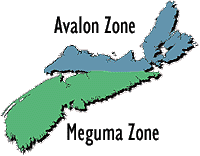| A Global View - Where was Nova Scotia? Very little is known of the
positions of the continents throughout most of the Precambrian Period. Sometime around
1,100 million years ago a large landmass called Laurasia began to form near the equator.
Another landmass (Gondwanaland) formed 750 million years ago. It seems to have been
located near the geographical south pole.
 A fault across Nova Scotia from Cobequid Bay to Chedabucto Bay neatly
divides the province into two geological zones which are fundamentally different from one
another. The zone north of the Cobequid-Chedabucto Fault (Cape Breton and northern
mainland Nova Scotia) is called the Avalon Zone. The Meguma Zone is the area south of the
fault (southern Nova Scotia). Prior to the Devonian Period, the Avalon and Meguma zones
developed in different areas and later came into contact along the Cobequid-Chedabucto
Fault. A fault across Nova Scotia from Cobequid Bay to Chedabucto Bay neatly
divides the province into two geological zones which are fundamentally different from one
another. The zone north of the Cobequid-Chedabucto Fault (Cape Breton and northern
mainland Nova Scotia) is called the Avalon Zone. The Meguma Zone is the area south of the
fault (southern Nova Scotia). Prior to the Devonian Period, the Avalon and Meguma zones
developed in different areas and later came into contact along the Cobequid-Chedabucto
Fault.
The Avalon and Meguma Zones are different because they belonged to different land
masses and were widely separated from one another. The Avalon Zone was part of Laurasia,
while the Meguma Zone belonged to Gondwanaland.
Rocks of Nova Scotia
The oldest rocks in Nova Scotia are the 1.4 billion year old gneiss, amphibolite and
marble known as the Polletts Cove River Group and are found at the northeastern tip of the
province. Not much is known about these rocks since the intense heat and pressure of
metamorphism during several orogenies (mountain building periods) obscured their original
compositions and structures. These old rocks were intruded by granite, diorite and
anorthosite that were also later metamorphosed and deformed.
Two other groups of rocks, the Great Village River Gneiss and Mount Thom Complex in the
Cobequid Highlands and the Kellys Mountain Gneiss and similar units in western Cape Breton
Island, reveal little about their origins because of later metamorphism during mountain
building. The Great Village River Gneiss, the Mt. Thom Complex and the Kellys Mountain
Gneiss are between 1000 and 750 million years old.
Sometime between 850 and 700 million years ago (after a period of mountain building),
erosion had reduced the high mountains to areas of lower relief. Here and in adjacent
seas, sandstones, shales and limestones (George River Group, Gamble Brook Formation,
McMillan Flowage Formation) were deposited unconformably on the older metamorphic rocks.
The end of the Precambrian era was a time of great volcanic activity, renewed mountain
building and igneous intrusions. Rock units such as the Jeffers Group, Folly River
Formation, Georgeville Group, Fourchu Group and similar units record the large volumes of
basaltic and rhyolitic lava flows and tuffs that erupted on land and into ocean
basins where muddy sediments were accumulating. The volcanism was a forerunner of the
collision of two crustal plates that produced a period of mountain building known as the
Avalonian Orogeny. Large amounts of dioritic and granitic magma were intruded into the
folded and metamorphosed volcanic rocks. The volcanism and intrusions created numerous
mineral deposits such as the copper-lead-zinc-gold deposit at Stirling and the copper and
copper-molybdenum deposits at Coxheath, both on Cape Breton Island.
In southeastern Cape Breton Island, a thick sequence of brownish-red sandstones and
rhyolitic lava flows of the Main-a-Dieu Group lies unconformably on top of the Late
Precambrian Fourchu Group. Fossils have not been found as yet but the rocks are considered
by some geologists to be transitional between Precambrian and Early Cambrian.
A lack of Precambrian rocks anywhere in the southern part of Nova Scotia is a
significant difference between the southern and northern parts of the province. Some
geologists believe that these old rocks do exist in southern Nova Scotia but are buried
under the Meguma Group except where they are exposed in gneiss domes in the Liscomb Game
Preserve.
Paleoenvironment
The Precambrian Period was a time of great volcanic activity, but it is mostly shrouded
in mystery. We do know that the first hard-shelled creatures evolved approximately 900
million years ago. It wasn't until 650 mya that multi-celled animals were present on
the planet.
The Precambrian rocks of Nova Scotia represent the remnants of volcanic islands
adjacent to a deep sea trench. Such a geological environment is illustrated today by the
Aleutian Islands west of Alaska. |
![]()